Janicza Bravo
The brilliant American director
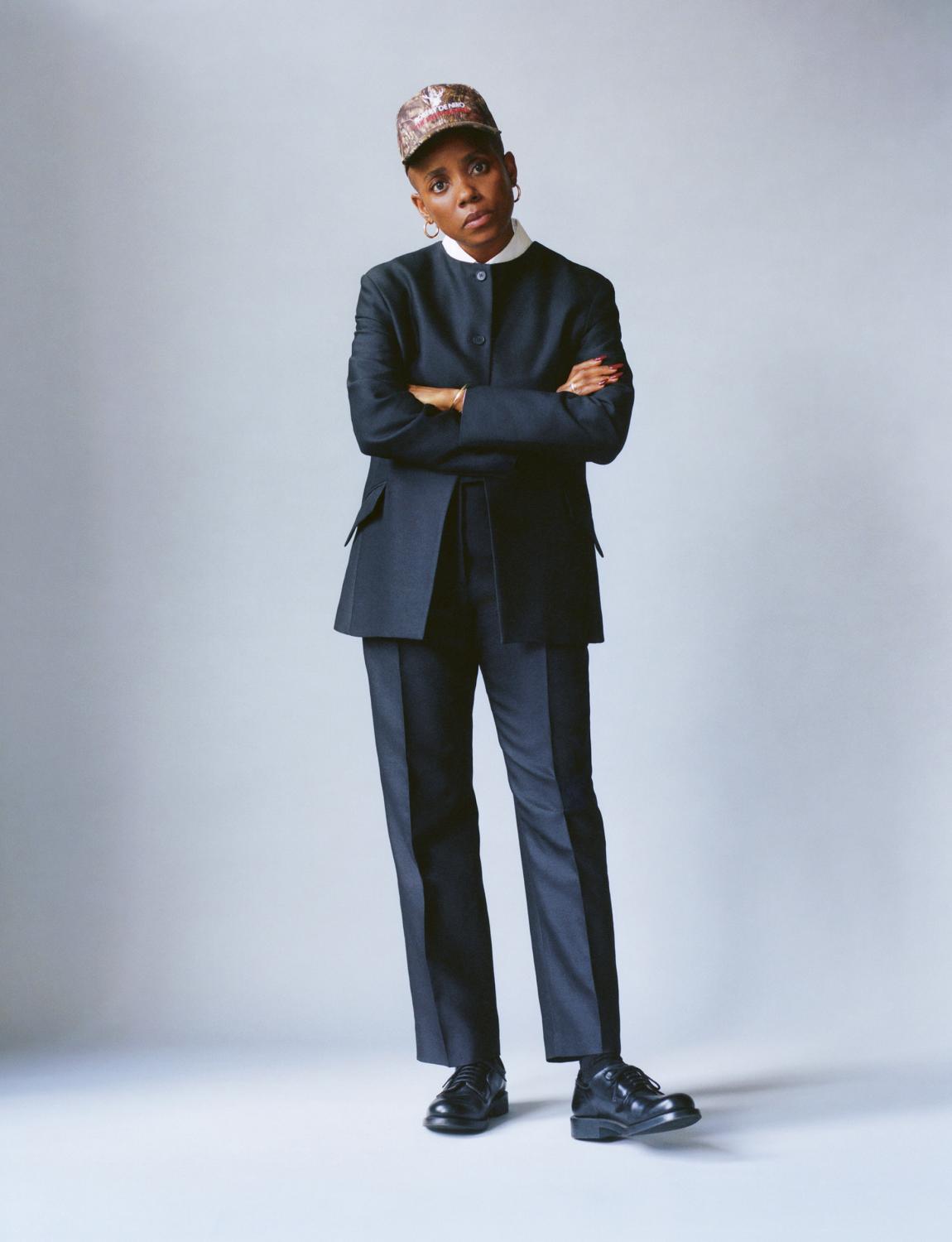
Portraits by Lola & Pani
Styling by Rudi Edwards
Issue nº 30, Autumn and Winter 2024
Janicza Bravo gleans creative inspiration in places the rest of us might zone out. In the case of her breakthrough film, Zola, it was scrolling the socials. Now, she’s taxi-hopping in the UK, attuning her ear and filming her BBC commission, The Listeners. Perhaps not incidentally, there were four TV sets in her three-inhabitant childhood home in Panama City, Panama.
When she is in LA the director Janicza Bravo likes to follow people around. She’ll go to a museum, eavesdrop on a conversation and decide to track it for a while, maybe writing down a line or two of dialogue: something to store for later. Since she has been living in the UK, working on the forthcoming BBC drama The Listeners, she has found people-watching a little trickier. She doesn’t have quite the same confidence away from home soil. So instead, she likes to sit in the back of a black cab, stare out the window and clock interesting characters. It all feeds in: reality providing nourishment, an endlessly renewing source of ideas but also pure entertainment. “The theatre of people on the streets,” as she describes it to me when we meet for lunch on a damp July day in central London.
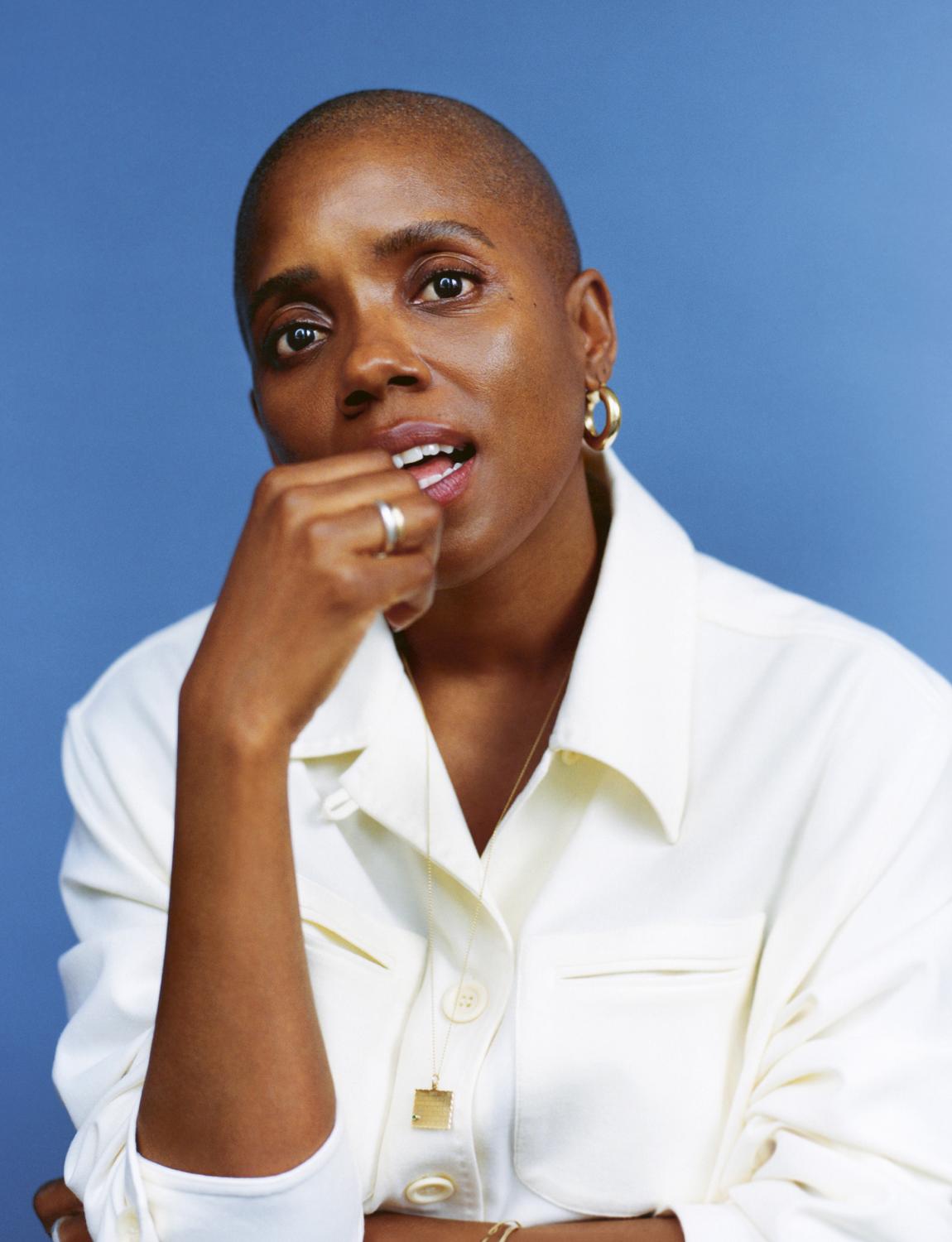
Janicza is wearing a white merino overshirt by CONNOLLY with her own gold earrings and necklace. She wears her own rings and bracelets throughout.
The theatre of people on the streets: it’s a good way of summing up Janicza’s slate of rich, dark, absurdist work to date. The stage was her first love and her area of training. She attended Playwrights Horizons Theater School at New York University from 1999 to 2003, and the education, her friend the playwright Jeremy O Harris tells me by WhatsApp from London, gave her a “love of the architecture of a space: she is incredibly detailed even on the page about the worlds her characters inhabit.” She then moved to Los Angeles, where she worked as a stylist and costume designer.
She was desperate to make films but couldn’t afford to stop working. Her then husband, the writer and actor Brett Gelman, intervened. “Brett sort of sat me down and said, ‘You keep waiting for someone to just give that to you, but no one’s going to give that to you.’” He told her she needed to make a short as a calling card, and he supported her while she wrote Eat (2011), in which Gelman acted with Katherine Waterston. “Brett was a big part of how I could afford to be a person that was just going to stay at home and write,” Janicza says. She took Eat to South by Southwest, where she met Michael Cera. “And that led to my next short, and so on.” Even so, she carried on working as a costume designer until 2013. Along the way, she gathered around her a kind of theatrical company of indie-favouring actors she would return to repeatedly: Cera, Waterston, Gaby Hoffmann, Alison Pill. “It is totally my dream to work in a theatre-company way,” she says.
In her shorts, Janicza established her mode: stories of dislocated people making thwarted attempts at connection, interrupted by moments of noirish farce. After Eat, she made Gregory Go Boom with Michael Cera – a bleakly comic, virtuosic work in which Cera plays a paraplegic on a series of fraught dates. It launched her into a new league, winning the Short Film Jury Award at Sundance in 2014. In all her shorts, there are moments of such frantic awkwardness that you want to turn away from the screen. In Gregory Go Boom, Cera spills his catheter bag all over the toilet seat of the woman he’s dating. In Pauline Alone (2014), Gaby Hoffmann tries to befriend a stranger on the street with the opening line “Terrific dog!” It’s theatre of the absurd, Brechtian, but also a study in discomfort.
Her longtime collaborator Joi McMillon, the Oscar-nominated Moonlight editor who worked with Janicza on her first feature, Lemon (2016), and the critically acclaimed Zola (2020), tells me by phone from LA that people often come out of the cinema and say how unnerved they felt. “And she’s like, ‘I love that.’ She loves to make people uncomfortable with her humour.” Many of Janicza’s jokes come in her cuts, made in partnership with McMillon, as when she ends a scene abruptly as a character is about to speak (a regular event in Lemon). “It is so much fun to make people feel off-kilter with these edits,” McMillon adds. Janicza tells me, “I feel what I traffic in is stress comedy.”
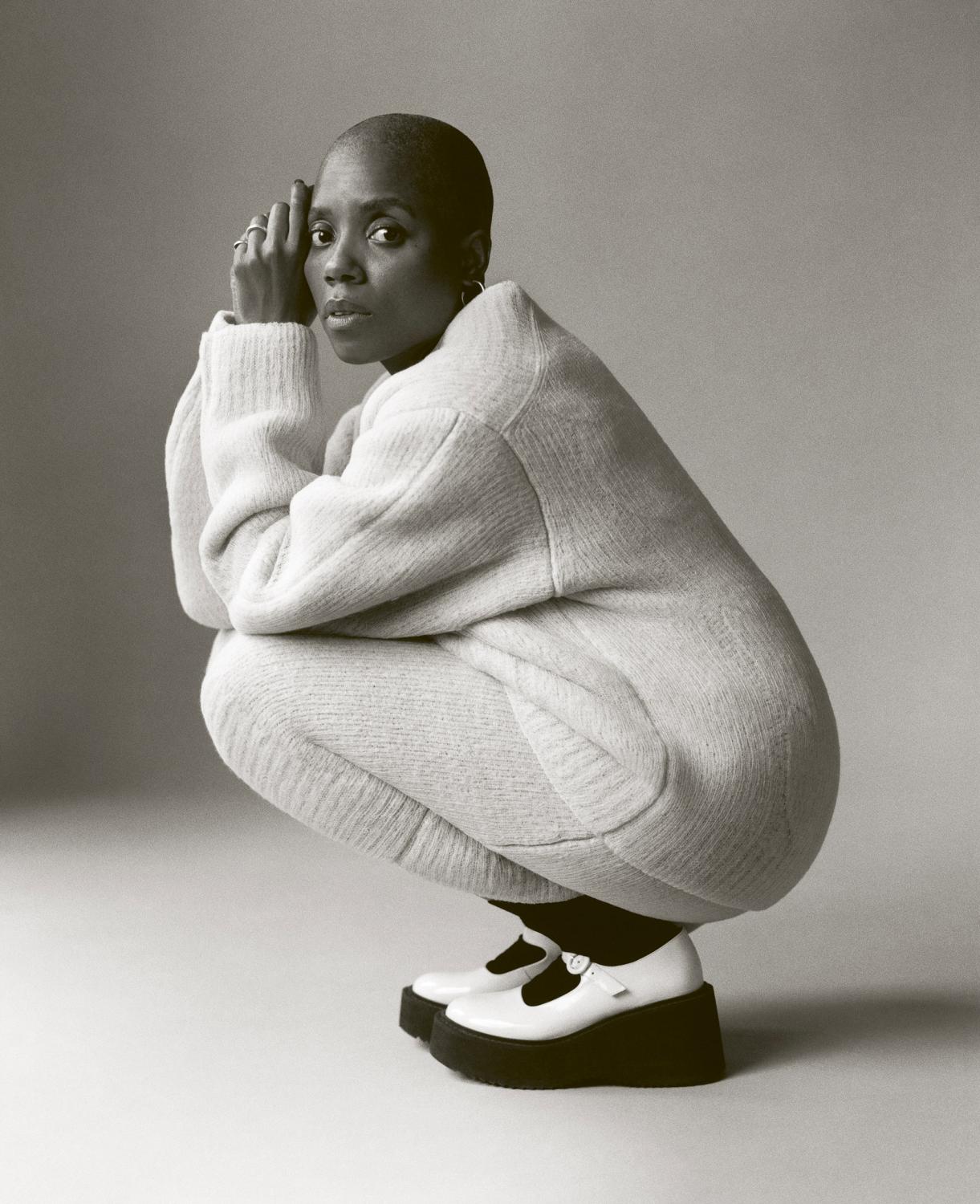
Janicza is in a light green chunky mohair V-neck jumper and matching skirt, both by JIL SANDER by Lucie and Luke Meier and three-millimetre gold hoops by TILLY SVEAAS. The white platform Mary Janes are Janicza’s own, and the black tights are the stylist’s.
“As a woman and as a person of colour, I think that I have to tell people what I’m capable of.”
The solution was to go in the opposite direction from what she had done before. “I was craving that, but only if it came my way naturally,” she says. “And only if it was something that felt right for me. And then this [The Listeners] popped into my lap, and it felt right.” The opportunity to work outside the US was both electrifying and anxiety-inducing. Janicza was frank with the producers: she could not bring authenticity to a British series. She hadn’t spent enough time in the UK; prior to The Listeners she had only briefly visited. “I have always been a tourist, and I’ll still be a tourist,” she told them. But The Listeners, based on the novel by the Canadian author, filmmaker and theatre director Jordan Tannahill, was tantalising: a four-part television drama that tells the story of Claire, a forty-something teacher (played by the actor and director Rebecca Hall) who starts hearing a constant low hum inaudible to almost everyone else. Tannahill, over email, tells me that Janicza was top of his list to direct the show. “Her work is often marked by these moments of the uncanny, these intrusions of the surreal into the everyday.” Janicza realised that her sense of alienation, her outsider’s gaze – noticing all the tiny things, all those little pieces of theatre on the street – could be an asset. “There are lots of things that I find very beautiful that you probably stopped looking at,” she says.
So what did she see in Britain? Driving around Leeds, Manchester and Liverpool with Tannahill, scouting for locations for Claire’s home, Janicza looked at countless new housing developments before she spotted the one she wanted. “It felt like we visited every new-build subdivision in England,” Tannahill says. The estate was across a reservoir and seemed to be carved out of the side of a mountain, all the houses precisely the same, on the edge between human civilisation and wilderness. Janicza was delighted by her discovery, “I was like, Oh, this is where bad things happen.” Janicza had grown up with an idea of what life in London might look like, “a Merchant Ivory version and a Working Title version,” as she puts it. The reality she encountered, or at least the version she portrays in The Listeners, is a wide-skied landscape of treeless moors interrupted by looming pylons and empty roads. Beautiful, yes, but sinister too.
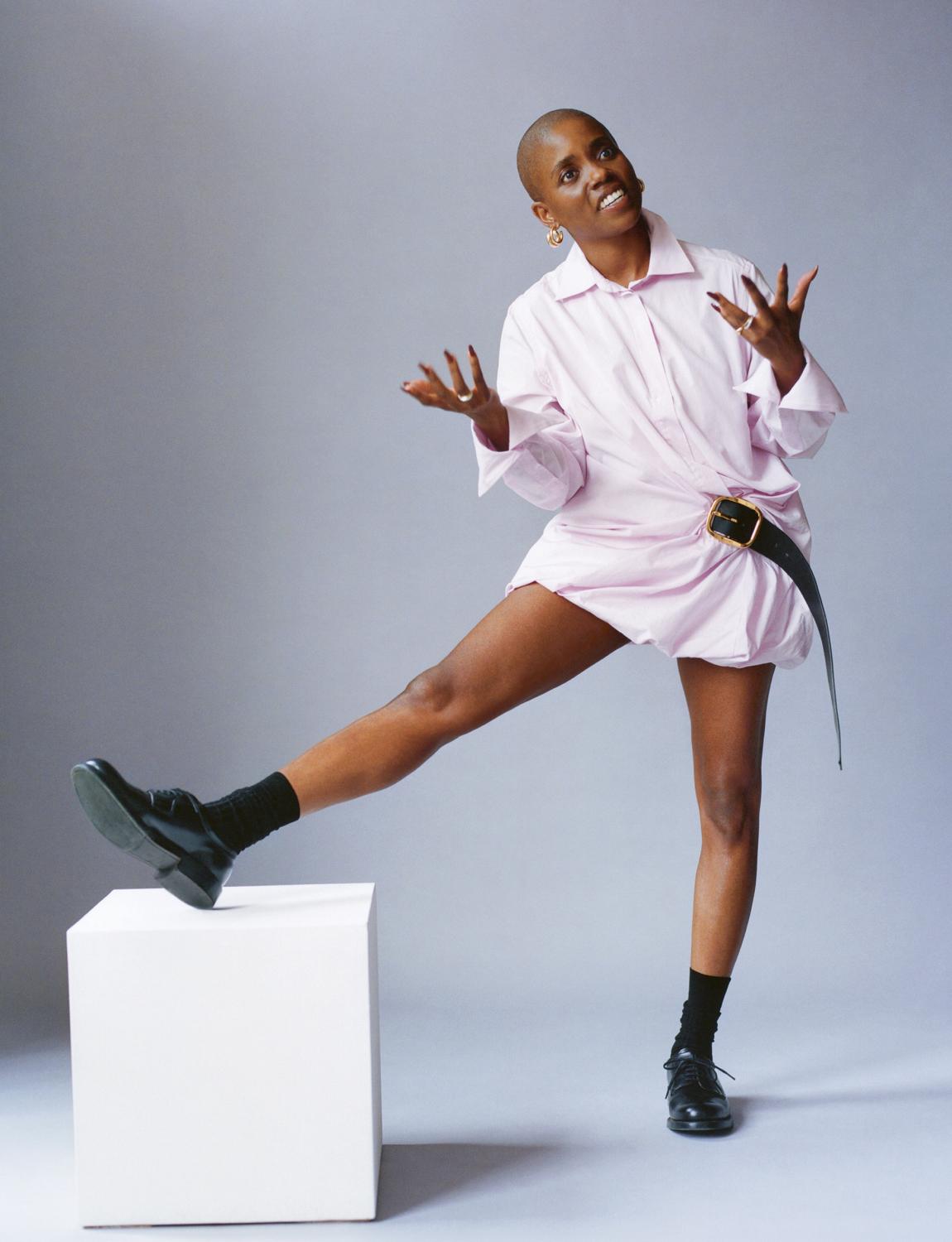
Janicza wears a pink cotton poplin belted shirt by LOEWE, with gold hoops by TILLY SVEAAS and black leather Camden derby shoes by GRENSON. The black socks are the stylist’s own.
Today, in the UK, where Janicza has been living between London and Manchester since April 2023, making and editing the new BBC drama The Listeners, her mode is less stress, more comedy, cut with a bracing honesty. She is small, just five foot five, and slight, yet she talks with such animation that she seems to take up double the space. Her look – a white knitted jumper, gold hoops, striped linen trousers, red clogs, a baseball cap with “The Deer Hunter” printed on it – is coolly distinct. “Whether she’s putting together an outfit or a scene,” McMillon says, “she is always concise and intentional.”
Janicza’s humour, meanwhile, swings hard at England, aiming first for the weather. “I’ve been robbed of two summers!” she cries, of her time in Manchester and now this washout of a season. “This is rude to me. It just feels really rude.” There are jokes to be found, too, in her attempts at dating in a small city. She had thought that when she moved to Manchester she would be enmeshed in her crew family, but they all turned up with their partners, so she started meeting people online. “There are people who rejected me on the apps who I would then run into on the street.” She bumped into one guy who thought he recognised her. “And I was like, ‘Oh, you stopped talking to me on Hinge.’”
Still, she is excited to be working in Britain. After Zola, an adaptation of a 148-tweet thread written by the Detroit waitress A’Ziah “Zola” King and posted on 27 October 2015, Janicza was in a position to choose her next project. She remembers reading the thread by chance and contacting her agent to ask how to acquire the rights to a series of tweets. The result was a savagely comic saga, co-written with Harris, which followed the chaotic road trip of two strippers. It was selected for Sundance and critically lauded; The New Yorker described it as having a combination of “unhinged action and rarefied realisation”. But Janicza knew its success meant she would be offered projects in the same vein. “My lane, I think, is more varied than I’ve been given credit for,” she says. “And as a woman and as a person of colour, I think that I have to tell people what I’m capable of.”
“There are lots of things that I find very beautiful in the UK that you probably stopped looking at.”
Janicza’s eye is her guide: for every project she makes mood boards and lookbooks, her vision informed by photography, paintings, films. (Tannahill describes her as a “film history savant”, always drawing on a wide pool of movements and directors.) When she was invited to reimagine the Rococo Revival Parlour at the Met as part of the Costume Institute’s 2022 exhibition, In America: An Anthology of Fashion, her starting reference was a Nan Goldin photograph of two women sitting on toilets in a nightclub bathroom, “Cookie and Millie in the Girl’s Room at the Mudd Club, NYC, 1979”. She can’t help but make even the most opulent spaces grounded and intimate.
She sent me a selection of the pictures she had used as visual inspiration for The Listeners: images by photographers such as Gregory Crewdson and Jamie Hawkesworth showing lone figures on lifeless suburban streets, a solitary van driving on a country lane; the 1948 painting “Christina’s World”, by the American artist Andrew Wyeth, of a young woman sprawled in a field, looking up at a bleak house on top of a hill. Each was somehow haunted, the figures conspicuously alone. “A lot of the characters I go after have a kind of loneliness or isolation about them,” Janicza says, “where it seems like they don’t have a home or are searching for something that looks like a home.”
When Janicza first read Tannahill’s book she felt an immediate connection. “I liked Claire,” she says. “I rooted for Claire. I saw myself in her, especially at this age.” Janicza is 43. “It was [about] not feeling understood. I would say a good deal of my life is [about] not feeling totally understood, that my experience is not validated. I was like, Oh, that’s the thing I can bring to this.”
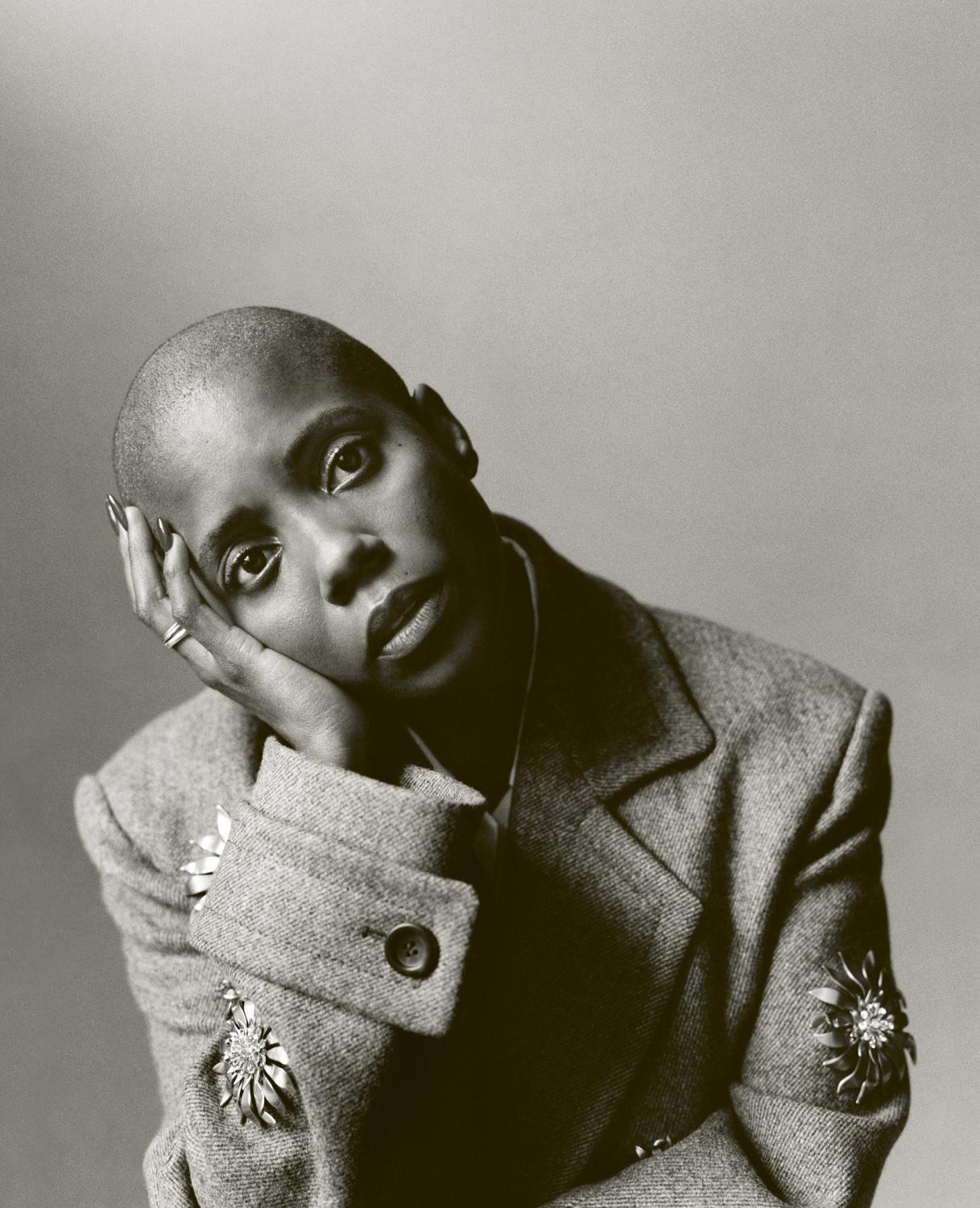
Double-wool coat and white poplin shirt, both by MIU MIU.
Janicza was born in Brooklyn, as the only child of two tailors. Her mother, Ana, joined the US army when Janicza was a few months old and was posted to Panama City and Colón. She was always making Janicza clothes – designed by Janicza. This was fine in Panama, when her daughter was in elementary school, but after they moved back to New York when Janicza was 12, the homemade, idiosyncratic aesthetic lost its cachet. “This was New York in the early 1990s, and everybody was wearing Nautica and Polo and Tommy Hilfiger,” she says. “And I was wearing lime-green linen palazzo pants and a wide collar and big giant buttons.” She can laugh about it now, but the sense of dislocation ran deep.
Though The Listeners is undoubtedly a different species of drama to Janicza’s earlier work, it contains plenty of her defining touches. There are shots that linger in both physical and moral discomfort: Claire with blood oozing from her nose; an exchange of inappropriately charged looks between Claire and her teenage pupil Kyle, played by Ollie West. To understand what is happening to her, Claire has to turn away from her family and her job, from the reliable order of a conventional life. Piece by piece, her life begins to unravel. “I was turned on by a woman who was choosing herself,” Janicza says, “whether or not it was convenient for other people.”
When Janicza’s relationship with Brett Gelman ended in 2018, her parents, with whom she now has a distant relationship – they still live in Brooklyn, while she is in LA – asked her what she had done wrong, implying the break-up must have been a disaster of her own making. In fact, she and Gelman “are still in each other’s lives.” When they separated she felt a new freedom, she tells me; for the first time in her life apart from six months in Spain when she was a student, she was living alone, the singular author of her own life. “Also, I was now really a working director, and I was making enough money to be able to pay rent on my own. So all of this lightness came from being able to take care of myself. It came from self-sufficiency.”
Now, when she is in LA, Janicza lives with her dog, close to a wide circle of creative friends. To hang out with her “is to be constantly laughing,” Tannahill says, “but she does not suffer a single fool.” She has her routine: her juice bar, her coffee place, regular Pilates and boxing. Her home, Joi McMillon says, is as delicately designed as her films. “You walk into her house and you’re like, I want that and I want that.” Janicza’s life is lived precisely on her chosen terms: she has no children and is now in a position not to do any project she does not fully believe in. As Janicza puts it, “I choose myself a lot.”
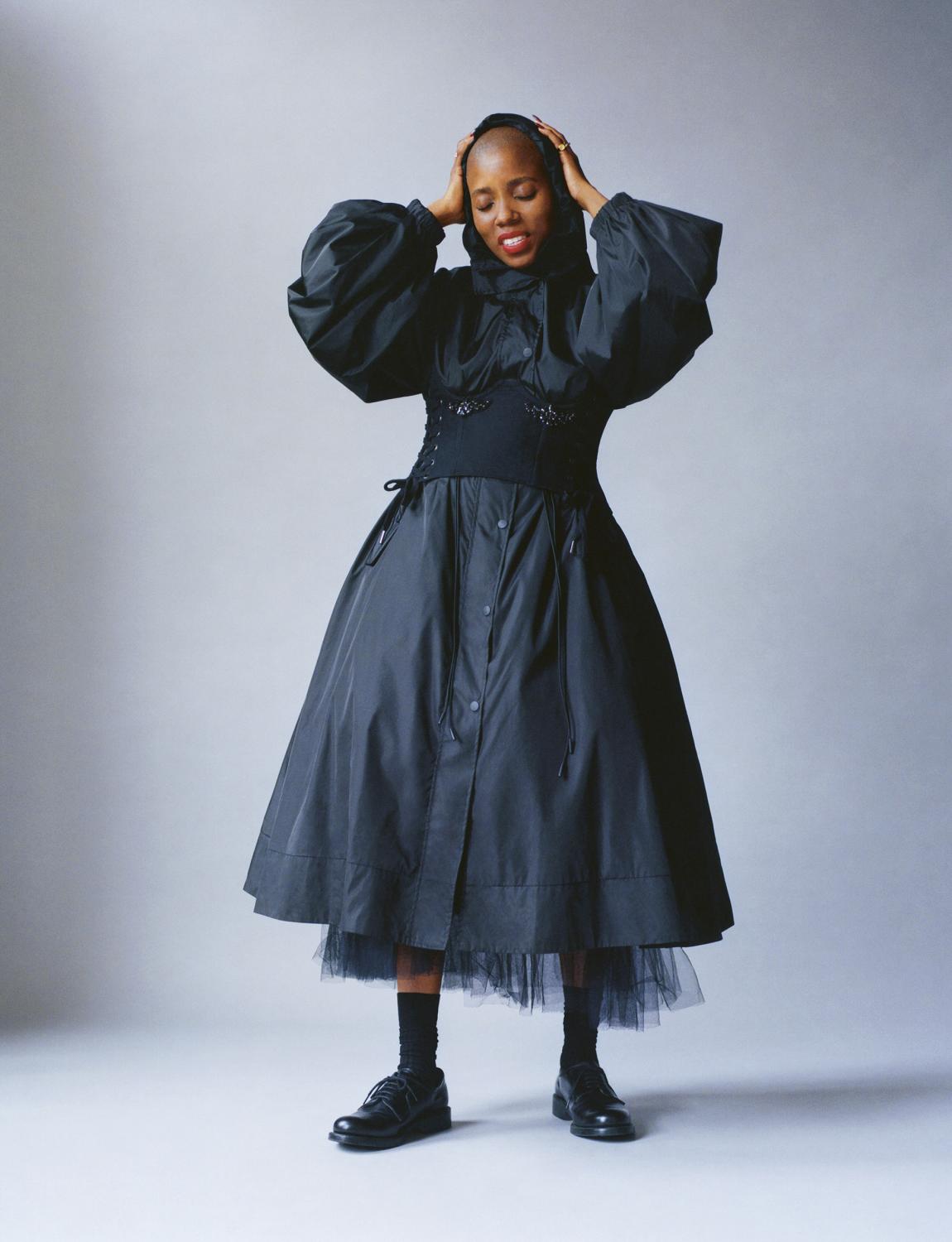
Janicza wears a black tulle lace-up corset over a black technical-nylon Trapeze jacket over a black net Turbo tutu. All are by SIMONE ROCHA. The black leather Camden derby shoes are by GRENSON and the black socks are the stylist’s own.
To be able to choose, Janicza knows, is a privilege, but it’s been hard-won. She was brought up, she says, to think there was only room for one. “I mean, one like me, right? Like there was only room for one Black person.” She thinks for a moment. “I don’t know that my parents consciously were rearing me that way. I think the world reared me that way.” What does she mean? “It’s the spaces I was in, right? I found myself in lots of white spaces.”
She gives an example. On the set of Women in Deep, her 2016 short film starring Alison Pill, Janicza was standing to one side, headphones on, as the crew was moving things into a beautiful house in Los Angeles. A guy got out of a truck and tapped her on the arm. “And he’s like, ‘When are you going to set up the coffee station?’” He had assumed she was the runner. In her analysis of that moment now, she doesn’t blame him. “It’s not that guy’s fault that he looked at me and went, ‘You’re the bottom of the barrel.’ That’s the industry he learned in; that’s what he’s seen, that’s what he’s known.” The numbers bear her out: in a 2024 report by the USC Annenberg School for Communication and Journalism, of the 116 directors attached to the 100 top-grossing American films of 2023, only 14, or 12 per cent, were women, down from 15 per cent in 2020. Of these, only four were women of colour.
Women in Deep was a defining experience. Janicza realised that she could never again be the only person who looked like her on set. “The reality is that I can either participate in scarcity or say that there isn’t scarcity and reach back and help somebody else. And I’m much more interested in the reach back. Right? I’m much more interested in holding the door open, because there isn’t fucking scarcity.”
The last few years, she feels, have changed the dynamic, but success has also allowed her to wield a certain power. Now the stipulation is there from the beginning: she insists on diversity among the cast and crew. The BBC has its own guidelines; each production must achieve 20 per cent diversity off screen. In Manchester it wasn’t easy. “The diversity conversation is not as advanced as it is in the States. I was like, ‘This is embarrassing. We should all be embarrassed.' I mean, it took work.”
For those she has worked with, such as Jeremy O Harris, the effect of her solidarity has been profound. “This business can feel very lonely for anyone, but especially minor-ities,” he tells me. “Having someone who you can trust with your vulnerability in every way has been invaluable.” The culture Janicza establishes on set is equally compelling, Joi McMillon says. “When you come to a project and a director has not only done their homework but built a world, it’s so much more exciting.” Janicza’s instinct, McMillon adds, is to nurture actors, guiding rather than instructing. For Harris it was more like working with an older sister, one you want to impress. “You want to please and exhilarate her, you want to surprise her, but you never, ever want to disappoint her,” he says. “Working with her was my greatest education in writing for the screen.”
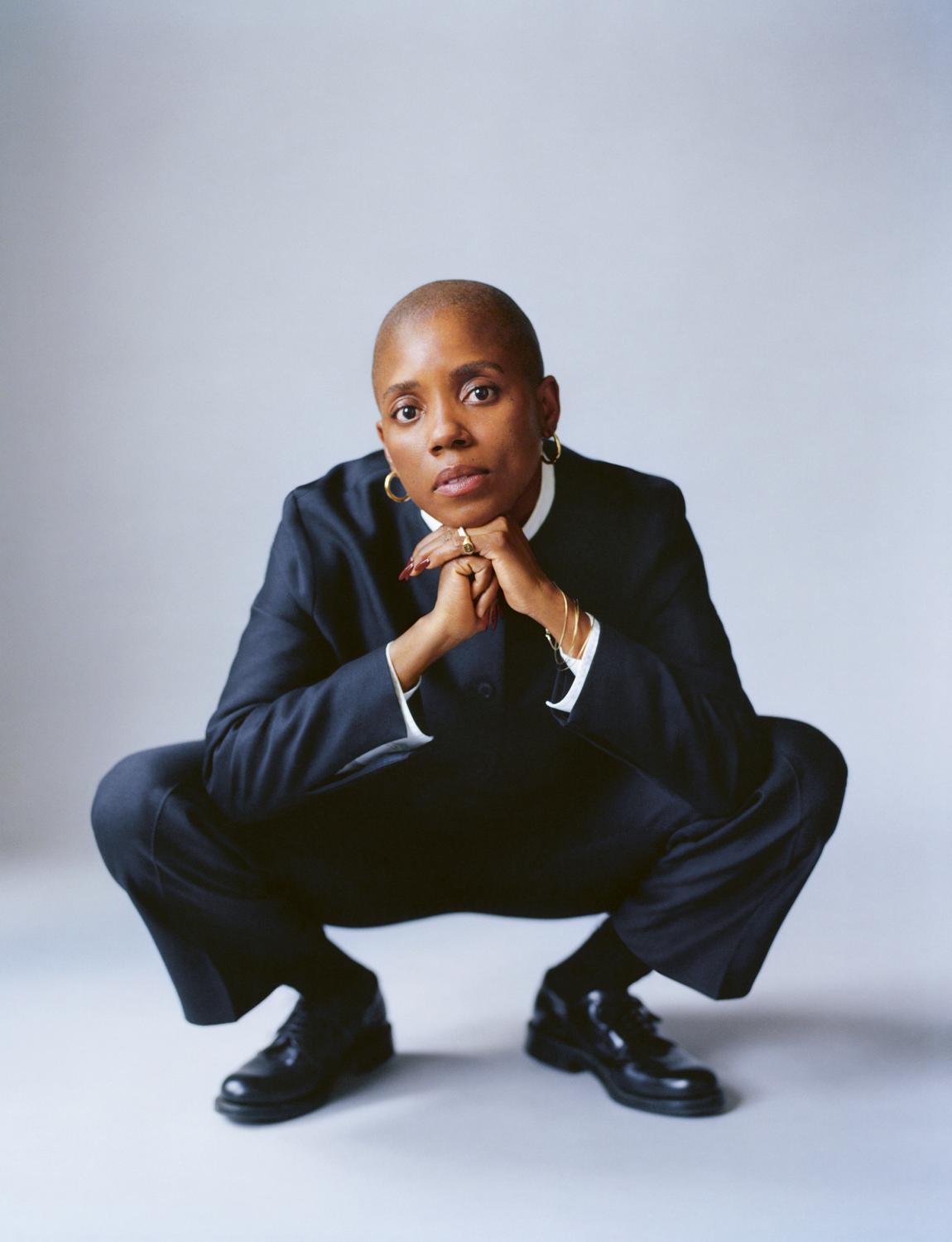
Janicza wears her own wool-and-silk suit by KALLMEYER with a white compact-cotton Simple shirt by MHL by MARGARET HOWELL, three-millimetre gold hoops by TILLY SVEAAS and black leather Camden derby shoes by GRENSON.
“All of this lightness came from being able to take care of myself. It came from self-sufficiency.”
In a few months, once the edit of The Listeners is complete, Janicza will return home, to the ocean, the palm trees, the warmth. Her joy at the prospect is visible. She has a rich mix of projects waiting for her attention, including adaptations of two knotty magazine stories: “A Suspense Novelist’s Trail of Deceptions”, Ian Parker’s 2019 New Yorker profile of the serial fabulist and vastly successful crime writer Dan Mallory, and “Who Is the Bad Art Friend?” by Robert Kolker, published in The New York Times Magazine in 2021 (this one will be made in collaboration with Tessa Thompson’s company, Viva Maude, and Harris). Both are morally complex tales which gained internet notoriety – just like the Twitter thread that prompted Zola. Both also involve living people, a fact that comes with moral complications for a filmmaker. “When someone’s alive and out in the world I have stress about how we paint them,” Janicza says. “Because once you film it it can be incredibly dangerous for a person.”
With Zola, for example, Janicza worked hard to protect and support A’Ziah King in the creative process and insisted she was given an executive producer credit. But there was still fallout, particularly when King wasn’t invited to the Film Independent Spirit Awards when Zola was nominated in seven categories. “I think it’s hilarious my intellect, trauma and talent is being overshadowed and hijacked,” King wrote on Instagram at the time, before clarifying that her ire was directed only at the producers, A24. “Not my peers, not the award shows, not the writers, not the director.”
In the case of Dan Mallory, the subject has at least already morally compromised himself. But the “Bad Art Friend” article, about two writers who fall out spectacularly, is more complicated. The story is one of friendship thwarted by professional ambition, shot through with painfully revealing social media interactions. It is psychologically fascinating, but “the women aren’t criminals,” Janicza says. They’re real people who have already suffered an internet pile-on after the publication of the original article. “The movie’s just going to bring it back up again. And then what is the ripple effect on their lives – on their working lives, their artist lives?” She knows she must tread carefully. But she also can’t resist: the story is firmly lodged in the ethically fraught, socially awkward territory in which she thrives. “To me it’s a really great comedy. So can we make a really great comedy without harming people?”
Before she can start unpicking that tangle, however, she has some complications of her own to resolve. Undaunted by the dating app mishaps in Manchester, Janicza has met someone, a British doctor, who she is now living with in London. They have yet to figure out how the relationship will work with an ocean between them, but it seems promising, not least because he is willing to go spying with her. The day before we met, they had taken an evening walk and happened to pass a couple saying goodbye. The man kissed the woman and then said to her, “Promise me you’re not going to the pub.” Janicza and her partner looked at each other. He said, “Do you want to see what happens?” The scene was already strung with tension, leaning inexorably towards disaster: ideal Janicza material. She looks gleeful. “I was like, ‘Yes.’”
Sophie ElmhirstLondon based journalist Sophie is a regular contributor to the Guardian, The New York Times, the New Yorker and the Financial Times. Honours in the Elmhirst cabinet include a British Journalism Award for feature writer of the year and a Foreign Press Association award for finance and economics story…read more Portraits by
Lola & PaniBlending elements of documentary, portraiture and fashion photography, Lola Paprocka and Pani Paul tease sentimental narratives and personal insights from their subjects. Patrons run the sartorial gamut, from Levi’s to Issey Miyake.read more Styling by
Rudi EdwardsBased between London and Paris, Yorkshirewoman Rudi is a beloved stylist whose varied portfolio includes three seasons of Modernisms for The Gentlewoman and collaborations with the knitwear supremo John Smedley.read more
Make up: Thomasin Waite at Julian Watson Agency, using Kjaer Weis. Manicure: Edyta Betka using CND. Photographic assistance: Cameron Williamson. Production: Canvas Represents.
This profile was originally published in The Gentlewoman nº 30, Autumn and Winter 2024.